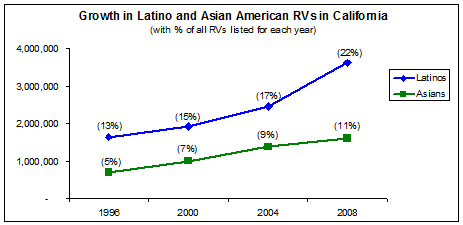Latino and Asian Americans are an important part of the American electorate, and this is perhaps most so in California, where the two groups account for nearly one third of the state’s registered voter population. In 2008, for instance, data from the Current Population Survey indicate that Latinos accounted for 22 percent of the registered voter population and Asian Americans accounted for nearly 11 percent of registered voters in 2008. No other state has a higher percentage of both Latino and Asians voters.
Both of these populations have also grown rapidly in terms of their electoral clout in statewide elections. Latinos went from being about 13 percent of registered voters in 1996 to 22 percent in 2008, according to the Current Population Survey, and the comparable increase for Asian Americans was from 5 percent to 11 percent. In contrast, the percent of all registered voters in California who are White has dropped from 72 percent in 1996 to 59 percent in 2008. With more and more immigrants choosing to naturalize, and with the children of immigrants getting older, the electoral importance of these two groups is projected to grow even larger. While California is already a majority-minority population state, it is clearly on a path to become a majority-minority electorate.

Given the importance of these two groups to the California electorate, it is little surprise that gubernatorial candidate Meg Whitman has spent millions of her advertising dollars on Spanish-language radio and television, and has in the last month begun to target Asian American voters as potential swing constituencies. Third-party groups have also invested in advertisements targeting voters in Spanish, and the Jerry Brown campaign has responded to Whitman’s ethnic advertising strategy by appealing to various Latino and Asian American advocates and elected officials.
Recently, Latino Decisions conducted a poll of both Asian and Latino registered voters in several states, and the results from California indicate that Whitman may indeed have an easier time trying to convince Asian American voters than Latino voters. However, her investment in Asian American outreach has come late in the campaign. The poll found that both groups tilt more towards the Democrats than the Republicans. However, there are more Republicans among Asian Americans in California than among Latinos (29% versus 17%), due largely to the significant numbers of Vietnamese Americans in the Orange County and San Jose metropolitan areas that identify heavily with the Republican Party. Also, twice as many Asian Americans identify as “pure independents”, meaning that they do not see themselves as pre-disposed to candidates from either major party, perhaps as a result of the lack of consistent partisan outreach to Asian Americans over the years in California.
Table 1: Party identification of Latino and Asian American voters in California
Latino Asian Strong Democrat 31% 18% Democrat 36% 13% Lean Democrat 7% 20% Pure Independent 10% 22% Lean Republican 5% 8% Republican 6% 13% Strong Republican 6% 8%
The same survey also shows that both Latinos and Asian American voters in California give somewhat high approval ratings for President Obama; 65 percent approval among Asians, and 75 percent approval among Latinos. However, Asian Americans in California are less attuned to the immigration debate than Latinos are. When asked how the two parties in Congress were handling immigration reform 42 percent of Asians said they didn’t know, compared to only 10 percent of Latinos who didn’t know. Asians are also less liberal on immigration reform. For example, 73 percent of Latinos in California favor a path to citizenship as part of comprehensive immigration reform, while only 49 percent of Asian American registered voters held the same opinions.
All of these patterns point to a potentially better showing for Whitman among Asian American voters than among Latinos, where current polls show her trailing badly among Hispanic voters. However, her investment in this increasingly-important electoral group (Asian Americans) may end up being too little, too late.
More generally, the Whitman campaign has recognized what many researchers have long declared—that Republican candidates cannot win statewide office without making sincere efforts to address the issues of concern to Latinos and Asian Americans. Without policy appeals, campaign stops, and political advertisements directed at these important constituencies, candidates cannot hope to win statewide office without capturing at least 30% to 40% of the votes of Asian Americans and Latinos. Buzzwords and catchphrases are not enough. Candidates need to get to know Asian and Latino voters and take seriously the campaign for the immigrant vote in California, or else face near-certain electoral defeat.
Karthick Ramakrishnan is Associate Professor of Political Science at the University of California, Riverside, and author of the book, Democracy in Immigrant America. He is also the co-principal investigator of the 2008 National Asian American Survey.

